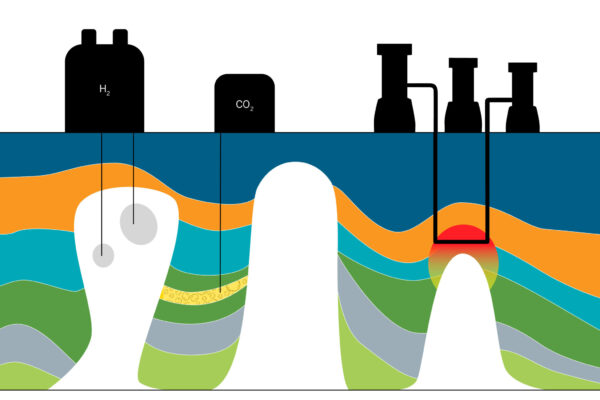2023-02-21 テキサス大学オースチン校(UT Austin)

Large underground salt formations can aid in the energy transition in myriad ways. Credit: UT Jackson School of Geosciences.
◆筆頭著者のOliver Duffy氏は、「私たちは、何十年にもわたる塩田地帯での研究、炭化水素探査、採掘から得られた知識とデータを、エネルギー転換技術に応用できる可能性を感じています」と述べています。”最終的には、塩の挙動をより深く理解することで、設計の最適化、リスクの低減、様々なエネルギー移行技術の効率化が可能になります。”
◆この研究は、雑誌「Tektonika」に掲載されました。
◆塩は、地球の地下層を形成する上で影響力のある役割を担っています。地質学的な力によって容易に複雑かつ巨大な堆積物に押し込められ、地下にはエベレストよりも高い塩の構造物も存在します。このような構造物やその周辺の地質は、エネルギー開発や排出権管理に多くの機会を提供すると、テキサス州の先進的資源回収(STARR)プログラムのディレクターである共著者のLorena Moscardelliは述べています。
◆塩のドームは、石油精製や石油化学産業で使用される水素の容器として実績がある。この論文によれば、塩のドームは、エネルギー生産に必要な水素の貯蔵所としても利用できる可能性がある。さらに、塩の周囲にある多孔質の岩石は、CO2の永久貯蔵スポットとして利用できる可能性がある。この研究では、「ブルー水素」と呼ばれる天然ガスからの水素製造と、CO2貯蔵を同時に行うことの利点が述べられています。水素を塩の洞窟に送る一方で、生産に伴って発生するCO2を周囲の岩盤に転用し、永久的に貯蔵することで、大気から遠ざけておくことができるのである。
<関連情報>
- https://news.utexas.edu/2023/02/21/salt-could-play-key-role-in-energy-transition/
- https://tektonika.online/index.php/home/article/view/11
エネルギー転換期における塩のテクトニクスの役割:概要と今後の課題 The Role of Salt Tectonics in the Energy Transition: An Overview and Future Challenges
Oliver Duffy,Michael Hudec,Frank Peel,Gillian Apps,Alex Bump,Lorena Moscardelli,Tim Dooley,Shuvajit Bhattacharya,Kenneth Wisian,Mark Shuster
Tektonika Published:2023-02-20
DOI:https://doi.org/10.55575/tektonika2023.1.1.11
Abstract
In this paper we examine the role salt tectonics can play in a number of key energy transition technologies, namely, energy storage as gas in salt caverns (e.g. hydrogen and compressed air), CO2 storage, and geothermal energy. For each of these technologies we explore: i) fundamental concepts and driving forces; ii) how and why the properties of salt are of importance; and iii) the key salt-related technical challenges, potential future research directions, and technical approaches needed for large-scale development. We highlight how salt-bearing basins offer vast potential for development throughout the energy transition including, but not limited to: i) the likely demand for thousands of new hydrogen storage caverns inside salt bodies by 2050; ii) a likely early focus for porous media CO2 storage sites in basins strongly influenced by salt tectonics; and iii) enhanced geothermal energy potential in and around salt bodies. Effective exploitation of these resources will require a deeper understanding of the internal composition, geometry, and evolution of salt structures and their surrounding sediments, and potentially the development of more predictive models of salt tectonic behaviour. Critically, we see the need to integrate learnings of salt tectonics gained in the academic, mining, solution mining, and oil and gas communities, and apply a fresh perspective to answer research questions of relevance to the energy transition. Developing this new understanding will help optimise design, reduce geotechnical risk, and improve efficiency for energy transition technologies, thus indicating a strong future demand for salt tectonic research.



